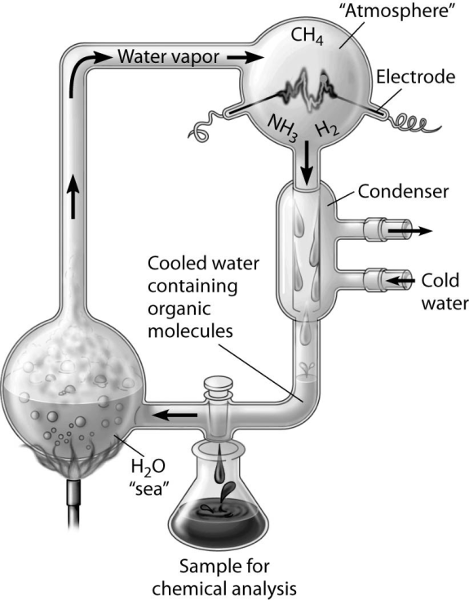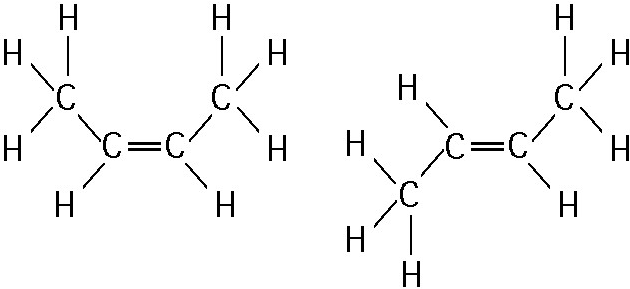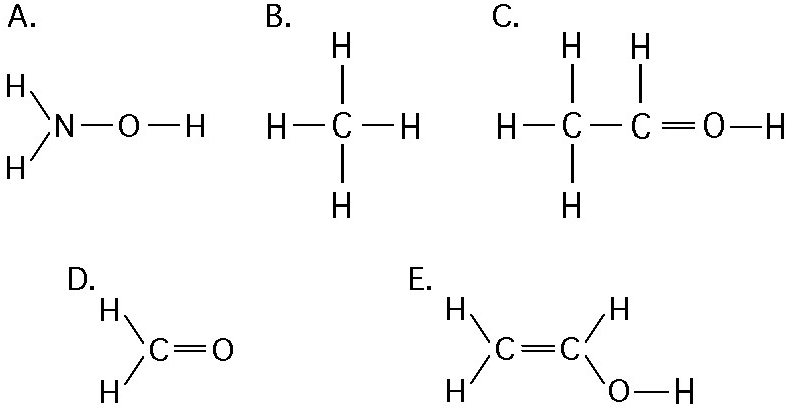The element present in all organic molecules is
A) hydrogen.
B) oxygen.
C) carbon.
D) nitrogen.
E) phosphorus.
Answer: C
The complexity and variety of organic molecules is due to
A)
the chemical versatility of carbon atoms.
B) the variety of rare
elements in organic molecules.
C) the fact that they can be
synthesized only in living organisms.
D) their interaction with
water.
E) their tremendously large sizes.
Answer: A
The experimental approach taken in current biological investigations
presumes that
A) simple organic compounds can be synthesized in
the laboratory from inorganic precursors, but complex organic
compounds like carbohydrates and proteins can only be synthesized by
living organisms.
B) a life force ultimately controls the
activities of living organisms and this life force cannot be studied
by physical or chemical methods.
C) although a life force, or
vitalism, exists in living organisms, this life force cannot be
studied by physical or chemical methods.
D) living organisms are
composed of the same elements present in nonliving things, plus a few
special trace elements found only in living organisms or their
products.
E) living organisms can be understood in terms of the
same physical and chemical laws that can be used to explain all
natural phenomena.
Answer: E
Differences among organisms are caused by
A) large differences
in elemental composition from organism to organism.
B)
differences in the types and relative amounts of organic molecules
synthesized by each organism.
C) differences in the elements
that bond with carbon in each organism.
D) differences in the
sizes of the organic molecules in each organism.
E) differences
in inorganic compounds present in each organism.
Answer: B
Which of the following people was the first to synthesize an organic
compound, urea, from inorganic starting materials?
A) Stanley
Miller
B) Jakob Berzelius
C) Friedrich Wohler
D)
Hermann Kolbe
E) August Kekulé
Answer: C
Stanley Miller's 1953 experiments proved that
A) life arose on
Earth from simple inorganic molecules.
B) organic molecules can
be synthesized abiotically under conditions that may have existed on
early Earth.
C) life arose on Earth from simple organic
molecules, with energy from lightning and volcanoes.
D) the
conditions on early Earth were conducive to the origin of life.
E) the conditions on early Earth were conducive to the abiotic
synthesis of organic molecules.
Answer: B
Hermann Kolbe's synthesis of an organic compound, acetic acid, from
inorganic substances that had been prepared directly from pure
elements was a significant milestone for what reason?
A) It
solved an industrial shortage of acetic acid.
B) It proved that
organic compounds could be synthesized from inorganic compounds.
C) It disproved the concept of vitalism.
D) It showed that
life originated from simple inorganic chemicals.
E) It proved
that organic compounds could be synthesized from inorganic compounds
and disproved the concept of vitalism.
Answer: E
Stanley Miller's 1953 experiments assumed that early Earth's
atmosphere contained
A) hydrogen cyanide, formaldehyde, hydrogen
gas, and water vapor.
B) ammonia, methane, hydrogen gas, and
water vapor.
C) ammonia, methane, oxygen gas, and water vapor.
D) amino acids, methane, hydrogen cyanide, and water vapor.
E) methane, formaldehyde, ammonia, and carbon dioxide.
Answer: B
When Stanley Miller applied heat and electrical sparks to a mixture
of simple inorganic compounds such as methane, hydrogen gas, ammonia,
and water vapor, what compounds were produced?
A) mostly amino
acids
B) only simple organic compounds such as formaldehyde and
cyanide
C) mostly hydrocarbons
D) only simple inorganic
compounds
E) both simple organic compounds and more complex
organic compounds such as amino acids and hydrocarbons
Answer: E
How many electron pairs does carbon share in order to complete its
valence shell?
A) 1
B) 2
C) 3
D) 4
E) 8
Answer: D
A carbon atom is most likely to form what kind of bond(s) with other
atoms?
A) ionic
B) hydrogen
C) covalent
D)
covalent bonds and hydrogen bonds
E) ionic bonds, covalent
bonds, and hydrogen bonds
Answer: C
Which of the following statements best describes the carbon atoms
present in a seed-eating bird?
A) They were incorporated into
organic molecules by plants.
B) They were processed into sugars
through photosynthesis.
C) They are ultimately derived from
carbon dioxide.
D) They were incorporated into organic molecules
by plants, and they are ultimately derived from carbon dioxide.
E) They were incorporated into organic molecules by plants, they
were processed into sugars through photosynthesis, and they are
ultimately derived from carbon dioxide.
Answer: E
Which of the following statements best describes the carbon atoms
present in a seed-eating bird?
A) Inorganic carbon atoms in the
seeds were incorporated into organic molecules by the bird.
B)
The carbon atoms ultimately came from the soil.
C) The carbon
atoms are ultimately derived from coal.
D) The carbon atoms
ultimately came from carbon dioxide incorporated into sugars through
photosynthesis.
E) The carbon atoms ultimately came from simple
organic compounds that formed abiotically from inorganic carbon,
hydrogen, oxygen, and nitrogen atoms.
Answer: D
Why are hydrocarbons insoluble in water?
A) The majority of
their bonds are polar covalent carbon-to-hydrogen linkages.
B)
The majority of their bonds are nonpolar covalent carbon-to-hydrogen
linkages.
C) They are hydrophilic.
D) They exhibit
considerable molecular complexity and diversity.
E) They are
lighter than water.
Answer: B
How many structural isomers are possible for a substance having the
molecular formula C₄H₁₀?
A) 1
B) 2
C) 4
D) 3
E) 11
Answer: B
Which of the following statements correctly describes cis-trans
isomers?
A) They have variations in arrangement around a double
bond.
B) They have an asymmetric carbon that makes them mirror
images.
C) They have the same chemical properties.
D) They
have different molecular formulas.
E) Their atoms and bonds are
arranged in different sequences.
Answer: A
Research indicates that ibuprofen, a drug used to relieve
inflammation and pain, is a mixture of two enantiomers; that is,
molecules that
A) have identical chemical formulas but differ in
the branching of their carbon skeletons.
B) are mirror images of
one another.
C) exist in either linear chain or ring forms.
D) differ in the location of their double bonds.
E) differ
in the arrangement of atoms around their double bonds.
Answer: B
What determines whether a carbon atom's covalent bonds to other atoms
are in a tetrahedral configuration or a planar configuration?
A)
the presence or absence of bonds with oxygen atoms
B) the
presence or absence of double bonds between the carbon atom and other
atoms
C) the polarity of the covalent bonds between carbon and
other atoms
D) the presence or absence of bonds with nitrogen
atoms
E) the solvent that the organic molecule is dissolved in
Answer: B
Compared to a hydrocarbon chain where all the carbon atoms are linked
by single bonds, a hydrocarbon chain with the same number of carbon
atoms, but with one or more double bonds, will
A) be more
flexible in structure.
B) be more constrained in structure.
C) be more polar.
D) have more hydrogen atoms.
E)
have fewer structurally distinct isomers.
Answer: B
Organic molecules with only hydrogens and five carbon atoms can have
different structures in all of the following ways except
A) by
branching of the carbon skeleton.
B) by varying the number of
double bonds between carbon atoms.
C) by varying the position of
double bonds between carbon atoms.
D) by forming a ring.
E) by forming enantiomers.
Answer: E
A compound contains hydroxyl groups as its predominant functional
group. Which of the following statements is true concerning this
compound?
A) It lacks an asymmetric carbon, and it is probably a
fat or lipid.
B) It should dissolve in water.
C) It should
dissolve in a nonpolar solvent.
D) It won't form hydrogen bonds
with water.
E) It is hydrophobic.
Answer: B
Which of the following is a false statement concerning amino groups?
A) They are basic in pH.
B) They are found in amino acids.
C) They contain nitrogen.
D) They are nonpolar.
E)
They are components of urea.
Answer: D
Which two functional groups are always found in amino acids?
A)
ketone and methyl
B) carbonyl and amino
C) carboxyl and
amino
D) amino and sulfhydryl
E) hydroxyl and carboxyl
Answer: C
Amino acids are acids because they always possess which functional
group?
A) amino
B) carbonyl
C) carboxyl
D)
phosphate
E) hydroxyl
Answer: C
A carbon skeleton is covalently bonded to both an amino group and a
carboxyl group. When placed in water it
A) would function only
as an acid because of the carboxyl group.
B) would function only
as a base because of the amino group.
C) would function as
neither an acid nor a base.
D) would function as both an acid
and a base.
E) is impossible to determine how it would function.
Answer: D
Which functional groups can act as acids?
A) amino and
sulfhydryl
B) carbonyl and carboxyl
C) carboxyl and
phosphate
D) hydroxyl and aldehyde
E) ketone and amino
Answer: C
Testosterone and estradiol are
A) soluble in water.
B)
structural isomers of each other.
C) proteins.
D) lipids.
E) enantiomers of each other.
Answer: B
Testosterone and estradiol are male and female sex hormones,
respectively, in many vertebrates. In what way(s) do these molecules
differ from each other?
A) Testosterone and estradiol are
structural isomers but have the same molecular formula.
B)
Testosterone and estradiol are cis-trans isomers but have the same
molecular formula.
C) Testosterone and estradiol have different
functional groups attached to the same carbon skeleton.
D)
Testosterone and estradiol have distinctly different chemical
structures, with one including four fused rings of carbon atoms, while
the other has three rings.
E) Testosterone and estradiol are
enantiomers of the same organic molecule.
Answer: C

Which of the following people used this apparatus to study the
formation of organic compounds?
A) Stanley Miller
B) Jakob
Berzelius
C) Friedrich Wohler
D) Hermann Kolbe
E)
August Kekulé
Answer: A

The two molecules shown in the figure above are best described as
A) optical isomers.
B) enantiomers.
C) structural
isomers.
D) cis-trans isomers.
E) chain length isomers.
Answer: C

The figure above shows the structures of glucose and fructose. These
two molecules differ in the
A) number of carbon, hydrogen, and
oxygen atoms.
B) types of carbon, hydrogen, and oxygen atoms.
C) arrangement of carbon, hydrogen, and oxygen atoms.
D)
number of oxygen atoms joined to carbon atoms by double covalent
bonds.
E) number of carbon, hydrogen, and oxygen atoms; the types
of carbon, hydrogen, and oxygen atoms; and the arrangement of carbon,
hydrogen, and oxygen atoms.
Answer: C

The figure above shows the structures of glucose and fructose. These
two molecules are
A) geometric isotopes.
B) enantiomers.
C) cis-trans isomers.
D) structural isomers.
E)
nonisotopic isomers.
Answer: D

The two molecules shown in the figure above are best described as
A) enantiomers.
B) radioactive isotopes.
C)
structural isomers.
D) nonisotopic isomers.
E) cis-trans isomers.
Answer: E

Three or four of the following illustrations depict different
structural isomers of the organic compound with molecular formula
C₆H₁₄. For clarity, only the carbon skeletons are shown; hydrogen
atoms that would be attached to the carbons have been omitted. Which
one, if any, is NOT a structural isomer of this compound?
[SEE IMAGE FOR CHOICES]
Answer: C

Which of the pairs of molecular structures shown below depict
enantiomers (enantiomeric forms) of the same molecule?
[SEE IMAGE FOR CHOICES]
Answer: D

Which of the pairs of molecular structures shown below do NOT depict
enantiomers (enantiomeric forms) of the same molecule?
[SEE IMAGE FOR CHOICES]
Answer: C

Which pair of molecules shown below are not enantiomers of a single
molecule?
[SEE IMAGE FOR CHOICES]
Answer: B

Thalidomide and L-dopa, shown below, are examples of pharmaceutical
drugs that occur as enantiomers, or molecules that
A) have
identical three-dimensional shapes.
B) are mirror images of one
another.
C) are structural isomers.
D) are mirror images
of one another and have the same biological activity.
E) are
cis-trans isomers.
Answer: B

What is the name of the functional group shown in the figure above?
A) carbonyl
B) ketone
C) aldehyde
D) carboxyl
E) hydroxyl
Answer: D

Which of the structures illustrated above is an impossible covalently
bonded molecule?
A) A
B) B
C) C
D) D
E) E
Answer: C

Which of the structures illustrated above contain(s) a carbonyl
functional group?
A) A
B) C and D
C) C
D) D
E) C and E
Answer: D

In which of the structures illustrated above are the atoms bonded by
ionic bonds?
A) A
B) B
C) C
D) C, D, and E
only
E) none of the structures
Answer: E

Which of the structures illustrated above cannot form hydrogen bonds
with water molecules?
A) A
B) B
C) C
D) D
E) E
Answer: B

Which functional group shown above is characteristic of alcohols?
A) A
B) B
C) C
D) D
E) E
Answer: A

Which functional group(s) shown above is (are) present in all amino
acids?
A) A and B
B) B and D
C) C only
D) D
only
E) C and D
Answer: E

Which of the groups shown above is a carbonyl functional group?
A) A
B) B
C) C
D) D
E) E
Answer: B

Which of the groups shown above is a functional group that helps
stabilize proteins by forming covalent cross-links within or between
protein molecules?
A) A
B) B
C) C
D) D
E) E
Answer: E

Which of the groups above is a carboxyl functional group?
A) A
B) B
C) C
D) D
E) E
Answer: C

Which of the groups above is an acidic functional group that can
dissociate and release H⁺ into a solution?
A) A
B) B
C) C
D) D
E) E
Answer: C

Which of the groups above is a basic functional group that can accept
H⁺ and become positively charged?
A) A
B) B
C) C
D) D
E) E
Answer: D

Which molecule shown above would have a positive charge in aqueous
solution at pH 7?
A) A
B) B
C) C
D) D
E) E
Answer: E

Which molecule(s) shown above is (are) ionized in aqueous solution at
pH 7?
A) A
B) B and D
C) D and E
D) D
E) E
Answer: A

Which molecules shown above contain a carbonyl group?
A) A and
B
B) B and C
C) B, C, and D
D) D and E
E) E
and A
Answer: B

Which molecule shown above has a carbonyl functional group in the
form of a ketone?
A) A
B) B
C) C
D) D
E) E
Answer: C

Which molecule shown above has a carbonyl functional group in the
form of an aldehyde?
A) A
B) B
C) C
D) D
E) E
Answer: B

Which molecule shown above contains a carboxyl group?
A) A
B) B
C) C
D) D
E) E
Answer: D

Which molecule shown above can increase the concentration of hydrogen
ions in a solution and is therefore an organic acid?
A) A
B) B
C) C
D) D
E) E
Answer: D

Which molecule shown above can form a dimer linked by a covalent
bond?
A) A
B) B
C) C
D) D
E) E
Answer: B

Which molecules shown above will form hydrogen bonds with water?
A) Only D will form hydrogen bonds with water.
B) All of
these molecules will form hydrogen bonds with water.
C) None of
these molecules will form hydrogen bonds with water.
D) All of
these molecules except B will form hydrogen bonds with water.
E)
Only C, D, and E will form hydrogen bonds with water.
Answer: D

Which molecule shown above contains an amino functional group, but is
not an amino acid?
A) A
B) B
C) C
D) D
E) E
Answer: A

Which molecule shown above is a thiol?
A) A
B) B
C)
C
D) D
E) E
Answer: B

Which molecule shown above contains a functional group that cells use
to transfer energy between organic molecules?
A) A
B) B
C) C
D) D
E) E
Answer: D

Which molecule shown above can function as a base?
A) A
B) B
C) C
D) D
E) E
Answer: A
A chemist wishes to make an organic molecule less acidic. Which of
the following functional groups should be added to the molecule in
order to do so?
A) carboxyl
B) sulfhydryl
C) hydroxyl
D) amino
E) phosphate
Answer: D
Organic chemistry is currently defined as
A) the study of
compounds made only by living cells.
B) the study of carbon
compounds.
C) the study of vital forces.
D) the study of
natural (as opposed to synthetic) compounds.
E) the study of hydrocarbons.
Answer: B

Which functional group is not present in this molecule?
A)
carboxyl
B) sulfhydryl
C) hydroxyl
D) amino
Answer: B
Which chemical group is most likely to be responsible for an organic
molecule behaving as a base?
A) hydroxyl
B) carbonyl
C) carboxyl
D) amino
E) phosphate
Answer: D
Which of the following hydrocarbons has a double bond in its carbon
skeleton?
A) C₃H₈
B) C₂H₆
C) CH₄
D) C₂H₄
E) C₂H₂
Answer: D

Choose the term that correctly describes the relationship between
these two sugar molecules:
A) structural isomers
B)
cis-trans isomers
C) enantiomers
D) isotopes
Answer: A

Identify the asymmetric carbon in this molecule.
A) A
B)
B
C) C
D) D
E) E
Answer: B

Which action could produce a carbonyl group?
A) the replacement
of the OH of a carboxyl group with hydrogen
B) the addition of a
thiol to a hydroxyl
C) the addition of a hydroxyl to a phosphate
D) the replacement of the nitrogen of an amine with oxygen
E) the addition of a sulfhydryl to a carboxyl
Answer: A